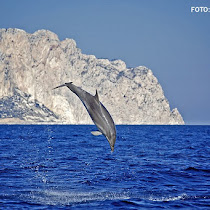
CpC Action Plan for Cetacean Studies
Weather permitting, collaborators will sail out and help volunteers to study dolphins. This work will include recording the geographical position, assessing group size, composition and formation, and observing the surface activity patterns and surfacing intervals. The study of ecology, behaviour and life history parameters of dolphins necessitates the need to identify the individuals within a population. We will apply photo-identification techniques and capture-recapture methods to estimate dolphin presence.
Sign in to join mission

 Created by
Created by
ciudadanosporlaciencia
1 participant
1 spotting
Frequently, marine reserves occur near a tourist hot spot in the Mediterranean. This is the case of Serra Gelada Natural Park which borders with a metropolis made up of Benidorm, L’Alfas de Pi and Altea, destinations for more than 2 million visitors per year.
In 2000, five years before the Serra Gelada was declared a protected area, two offshore fish farms were established in the current Natural Park, at that time beginning the production of Gilthead seabream (Sparus aurata) and European seabass (Dicentrarchus labrax). Opportunistic sightings in Altea Bay, the area within the protection boundaries where floating fish enclosures were already installed, strongly suggested that dolphins were attracted by the fish farms, and the number of sightings increased after 2000. Thus, the high rate of dolphin presence, which is continuous through the year, with a maximum absence period of no longer than 4 days (Esteban, J.A. and Castellote, M. 2009. Bottlenose dolphin seasonal pattern and habitat use in the Coastal Reserve of Serra Gelada, Alicante, Spain. Poster. European Cetacean Society Congress, Stralsund, Germany, 21-25 march 2010) is a relatively new phenomenon, and dolphin watching is not yet offered to tourists on the urban coast near Serra Gelada Natural Park, where 90.000 people sail every year.
The general purpose of the project is to unite tourists and the local population in the conservation of an emotive species, the Bottlenose Dolphin (Tursiops truncatus). The aim is to identify the dolphin population structure, and the relationship of the dolphins to fish farms and local fisheries, as well as identifying how they move, implementing, at the same time, a sustainable tourism based on conservation.
The specific objectives are four:
• Objective 1: The principal aim is to develop sustainable dolphin watching tourism within the conservation framework. Visitors will contribute both by voluntary sailing for surveys and by means of donations.
• Objective 2: To follow the dolphin population by photoidentification (hereafter photo ID) and mark-recapture methods. Monitoring will focus on their interaction with fish farms.
• Objective 3: The collaboration of conservationist associations, local councils, aquaculture, nautical and hosting companies.
• Objective 4: To promote a network of citizens for the study and conservation of cetacean.








